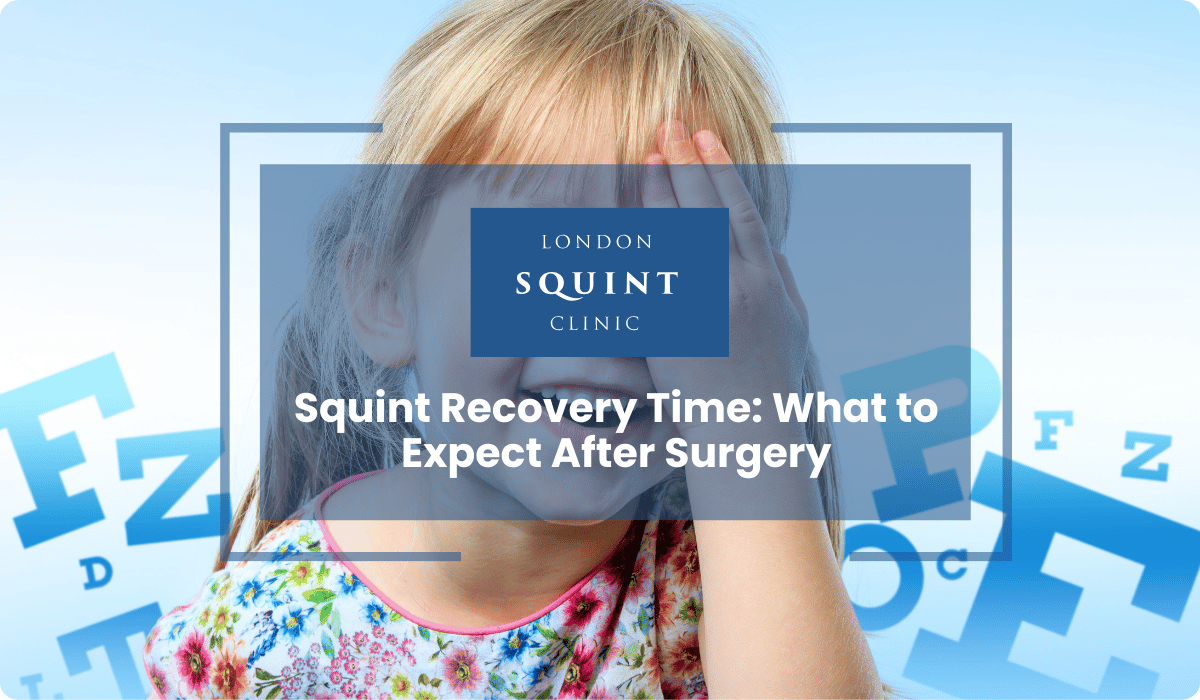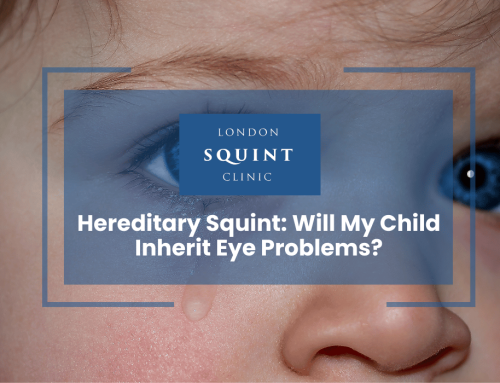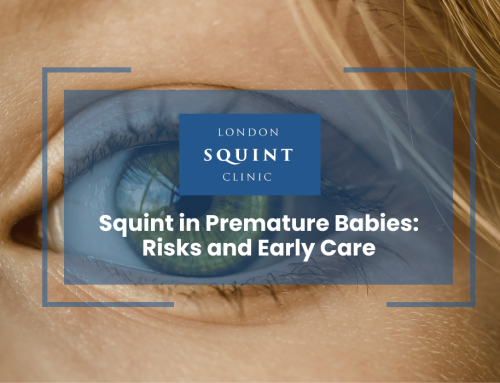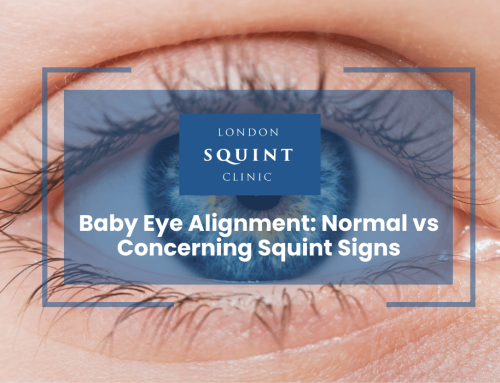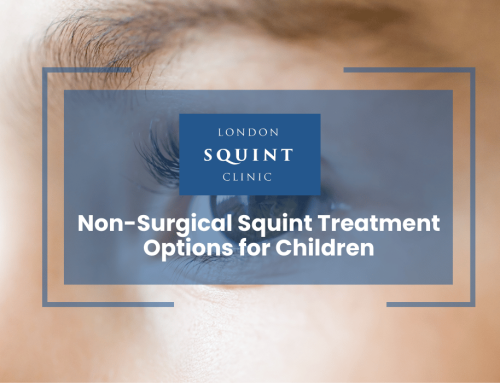Squint Recovery Time: What to Expect After Surgery
Squint Recovery
- First 48 hours are critical – Expect redness, swelling, and discomfort; administer pain medication as directed and use cold compresses to reduce swelling.
- Gradual return to activities – Most children can return to school within 1-2 weeks, but avoid swimming for 3-4 weeks and contact sports for 4-6 weeks.
- Watch for warning signs – Contact your surgeon immediately if you notice worsening redness, yellow/green discharge, severe pain, vision changes, or fever.
- Complete healing takes time – While visible signs fade within a month, internal healing and visual adaptation continue for 3-6 months.
- Follow-up appointments are essential – Attend all scheduled check-ups to monitor healing, assess alignment, and address concerns promptly.
- Consistency with prescribed treatments – Maintain glasses wear, patching therapy, or exercises as recommended to optimize long-term outcomes.
Table of Contents
- Understanding Squint Surgery: A Parent’s Guide
- The First 48 Hours: Critical Post-Operative Care
- Week 1-2: Early Recovery Milestones After Strabismus Surgery
- How Long Until My Child Can Return to Normal Activities?
- Managing Discomfort and Complications During Recovery
- Long-Term Healing: What to Expect in Months Following Surgery
- Follow-Up Care: Ensuring Optimal Surgical Outcomes
Understanding Squint Surgery: A Parent’s Guide
Squint surgery (strabismus surgery) is a common procedure performed to correct misalignment of the eyes in children. As a parent, understanding what to expect during the recovery period is crucial for supporting your child through this journey. The surgery involves adjusting the eye muscles to improve alignment, which can significantly enhance both the cosmetic appearance and visual function of your child’s eyes.
The recovery timeline for squint surgery varies from child to child, typically ranging from a few weeks for basic activities to several months for complete healing. Factors influencing recovery include the complexity of the procedure, your child’s age, overall health, and how well post-operative care instructions are followed. Most children experience significant improvement in eye alignment within the first few weeks, though the final results may take longer to stabilise.
Before surgery, your ophthalmologist will provide specific pre-operative instructions, which may include fasting guidelines and medication adjustments. It’s important to prepare your child emotionally as well, explaining the procedure in age-appropriate terms and reassuring them about the recovery process. Having comfortable, loose-fitting clothes ready for the day of surgery and arranging for quiet activities during the initial recovery period at home can make the experience smoother for everyone involved.
The First 48 Hours: Critical Post-Operative Care
The initial 48 hours following squint surgery represent the most intensive period of recovery for your child. During this time, your child may experience redness, swelling, and discomfort around the operated eye(s). These symptoms are normal and typically peak within the first 24 hours before gradually subsiding. Your child’s eyes may also produce more tears than usual, and you might notice a pinkish discharge, which is typically a mixture of tears and residual blood from the surgery.
Pain management is essential during this period. Your surgeon will prescribe appropriate pain relief medication, usually in the form of paracetamol or ibuprofen. It’s important to administer these as directed rather than waiting for your child to complain of pain. Cold compresses applied gently to the closed eyelids for short periods (5-10 minutes) can help reduce swelling and provide comfort, but avoid applying pressure to the eyes.
Eye drops or ointments will be prescribed to prevent infection and reduce inflammation. These need to be administered exactly as directed, even if your child resists. A helpful technique is to have your child lie down with eyes closed, place the drop in the inner corner of the eye, and then have them open their eye to allow the medication to flow in naturally. During sleep, position your child’s head slightly elevated to reduce swelling, and encourage them to avoid touching or rubbing their eyes, which might require gentle reminders or even soft mittens for very young children.
During these first two days, your child should rest as much as possible in a calm, dimly lit environment. Limit screen time and reading to reduce eye strain. Offer soft, easy-to-eat foods that don’t require much chewing to minimise movement of facial muscles near the eyes. Stay vigilant for any signs of complications such as excessive pain, significant swelling, or changes in vision, and contact your surgeon immediately if these occur.
Week 1-2: Early Recovery Milestones After Strabismus Surgery
As your child moves beyond the initial 48 hours, the recovery process enters a new phase characterised by gradual improvement. During weeks 1-2, you’ll likely notice a significant reduction in redness and swelling around the eyes. The bright red appearance of the eye surface (conjunctiva) will begin to fade to a lighter pink. Your child’s comfort level should improve considerably, though some children may still experience mild irritation or a feeling of grittiness in the eyes.
Vision may initially be blurry or double in the first week, which is completely normal as the brain adjusts to the new eye alignment. This typically improves gradually, though some fluctuations in vision and alignment are common during this period. Your child might blink more frequently or be more sensitive to light, so having sunglasses available for outdoor activities can be helpful.
During this early recovery phase, your child can begin to resume light indoor activities. Reading, watching television, and using digital devices in moderation is usually permitted after the first few days, though it’s best to limit these activities to short periods and ensure proper lighting to reduce eye strain. Most children can return to school after 7-10 days, though this varies based on individual recovery and your surgeon’s specific recommendations.
Medication routines remain important during this period. Continue administering prescribed eye drops or ointments according to schedule, even as symptoms improve. If your child was prescribed oral antibiotics or anti-inflammatory medications, complete the full course as directed. By the end of the second week, many children have significantly reduced discomfort and are well on their way to recovery, though complete healing of the surgical site continues internally.
How Long Until My Child Can Return to Normal Activities?
Parents frequently ask about the timeline for resuming normal activities after squint surgery. While every child’s recovery is unique, there are general guidelines that can help you plan for your child’s return to routine activities. Most children can return to school within 1-2 weeks after surgery, depending on their comfort level and your surgeon’s recommendations. When your child does return to school, it’s advisable to inform teachers about the recent surgery and any activity restrictions.
For physical activities, a graduated return is recommended. Light play and walking can usually resume after the first week, but more vigorous activities require patience. Non-contact sports and moderate physical activities typically can be reintroduced after 2-3 weeks. However, high-impact or contact sports should be avoided for at least 4-6 weeks to prevent trauma to the healing eyes. Swimming deserves special mention – children should avoid swimming pools, lakes, and oceans for at least 3-4 weeks after surgery to prevent exposure to potentially contaminated water that could lead to infection.
Regarding screen time and reading, these activities can usually be resumed gradually after the first few days, but moderation is key. Encourage your child to take frequent breaks to prevent eye strain. For younger children who attend nursery or playgroups, a return after 10-14 days is generally appropriate, provided they can avoid rough play and sand pits.
Air travel is generally safe after 2-3 weeks, but it’s advisable to consult with your surgeon before planning any trips. The pressurised cabin environment can sometimes cause mild discomfort in recently operated eyes. For children who wear glasses, your ophthalmologist will advise when to resume wearing them – typically within a few days of surgery – and whether any prescription changes are needed. Some children may need to adjust to new prescriptions after squint surgery, as their visual needs may change with improved eye alignment.
Managing Discomfort and Complications During Recovery
While squint surgery recovery is generally straightforward, managing your child’s comfort effectively is essential for a smooth healing process. Most children experience mild to moderate discomfort rather than severe pain. This discomfort typically manifests as a scratchy or gritty sensation, sensitivity to light, or a feeling of pressure around the eyes. Regular administration of prescribed pain relief medication during the first few days can significantly improve comfort, even if your child doesn’t actively complain of pain.
Beyond medication, several comfort measures can be helpful. Lubricating eye drops (artificial tears) can relieve dryness and the gritty sensation that many children experience. Cool compresses applied gently to closed eyelids for short periods can reduce swelling and soothe irritation. Creating a calm, dimly lit environment at home during the early recovery period can also help minimise discomfort from light sensitivity.
While complications after squint surgery are uncommon, it’s important to recognise potential warning signs. Contact your surgeon immediately if you notice excessive redness that worsens rather than improves, significant swelling, discharge that is yellow or green (suggesting infection), severe or worsening pain, changes in vision, or if your child develops a fever. Very rarely, more serious complications such as infection, excessive bleeding, or an allergic reaction to medications may occur.
Some children may experience temporary side effects that, while not complications, can be concerning for parents. These include mild double vision as the brain adjusts to the new eye alignment, temporary over-correction or under-correction of the squint, or small subconjunctival haemorrhages (bright red patches on the white of the eye). These effects are typically part of the normal healing process and resolve with time, but should be mentioned at follow-up appointments. If your child had adjustable sutures placed during surgery, they might feel these as a slight roughness under the eyelid, which is normal until they dissolve.
Long-Term Healing: What to Expect in Months Following Surgery
The long-term healing process after squint surgery extends well beyond the initial recovery period. While most visible signs of surgery fade within the first month, internal healing and visual adaptation continue for several months. During this extended recovery phase, you may notice subtle changes in your child’s eye alignment as the muscles adapt to their new positions. Some fluctuation in alignment is normal and typically stabilises over time.
Visual development continues throughout this period, particularly in younger children. The brain gradually adapts to the new eye alignment, which can lead to improvements in depth perception and binocular vision (the ability of both eyes to work together). This neural adaptation process is especially important in children with amblyopia (lazy eye) who may require ongoing treatment such as patching or special glasses to optimise visual outcomes.
By 3-6 months post-surgery, most children have reached their final surgical outcome in terms of eye alignment. However, it’s important to understand that in some cases, particularly for complex squints, the full benefits of surgery may take up to a year to become apparent. Throughout this period, maintaining regular follow-up appointments is crucial to monitor progress and address any concerns.
For some children, especially those with certain types of squint or underlying conditions, there is a possibility that the eyes may gradually drift from their corrected position over time. This occurs in approximately 20-30% of cases and may eventually require additional surgery. This isn’t a sign that the initial surgery failed, but rather reflects the complex and sometimes progressive nature of strabismus conditions. Your ophthalmologist will monitor for any signs of regression during follow-up visits and can discuss further interventions if needed.
During this long-term healing phase, maintaining any prescribed glasses wear or vision therapy is essential for optimising outcomes. Some children may need adjustments to their glasses prescription as their vision and eye alignment stabilise. By understanding that squint surgery is often part of a comprehensive treatment approach rather than a one-time fix, parents can better support their child’s ongoing visual development.
Follow-Up Care: Ensuring Optimal Surgical Outcomes
Consistent follow-up care plays a crucial role in maximising the success of your child’s squint surgery. A typical follow-up schedule includes an initial post-operative check within the first week after surgery, followed by appointments at approximately 6 weeks, 3 months, 6 months, and 12 months. This schedule may be adjusted based on your child’s specific needs and recovery progress. These appointments allow your ophthalmologist to monitor healing, assess eye alignment, and address any concerns promptly.
During follow-up visits, your ophthalmologist will perform several assessments, including measuring visual acuity, checking eye alignment in different gaze positions, and evaluating how well the eyes work together. They may also assess depth perception and conduct a dilated eye examination to check the health of the retina and optic nerve. Be prepared to discuss any observations you’ve made about your child’s vision or eye appearance between appointments, as these insights can be valuable for the clinical assessment.
Compliance with prescribed treatments between appointments is essential for optimal outcomes. This may include administering eye drops, ensuring your child wears their glasses consistently, or implementing patching therapy for amblyopia if recommended. Some children may benefit from orthoptic exercises to strengthen binocular vision and eye coordination. Your orthoptist can demonstrate these exercises and provide guidance on how to incorporate them into your daily routine.
It’s important to maintain open communication with your healthcare team throughout the follow-up period. Don’t hesitate to contact your ophthalmologist if you notice any concerning changes in your child’s vision or eye alignment between scheduled appointments. Early intervention for any issues that arise can significantly improve long-term outcomes. Additionally, keep detailed records of your observations, any medications administered, and questions that arise between visits to make follow-up appointments more productive.
Remember that squint surgery is often part of a longer journey toward optimal visual function. Some children may require additional interventions, such as vision therapy, updated glasses prescriptions, or in some cases, further surgery to achieve the best possible outcome. By maintaining consistent follow-up care and adhering to your ophthalmologist’s recommendations, you provide your child with the best opportunity for long-term visual success and eye health.
Frequently Asked Questions
How long does it take to recover from squint surgery?
Recovery from squint surgery typically takes 2-6 weeks for basic activities, though complete healing continues for several months. Most children can return to school after 7-10 days, resume light activities after 1-2 weeks, and participate in non-contact sports after 2-3 weeks. However, contact sports should be avoided for 4-6 weeks, and swimming should be postponed for 3-4 weeks. Final surgical outcomes in terms of eye alignment typically stabilize by 3-6 months post-surgery.
Is squint surgery painful for children?
Squint surgery typically causes discomfort rather than severe pain in children. Most experience a scratchy or gritty sensation, light sensitivity, and pressure around the eyes during the first few days. Regular administration of prescribed pain medications (usually paracetamol or ibuprofen) effectively manages this discomfort. Cold compresses, lubricating eye drops, and a calm, dimly lit environment can further enhance comfort during recovery.
What are the signs of complications after strabismus surgery?
Signs of complications after strabismus surgery include: excessive redness that worsens rather than improves, significant swelling, yellow or green discharge (indicating infection), severe or worsening pain, unexpected vision changes, or fever. While mild double vision, temporary over/under-correction, and small red patches on the eye white are normal parts of healing, parents should contact their surgeon immediately if they observe any concerning symptoms.
When can my child return to school after squint surgery?
Most children can return to school 7-10 days after squint surgery, depending on their comfort level and surgeon’s recommendations. When returning to school, inform teachers about the surgery and any activity restrictions. Children should avoid playground activities like sand pits and rough play for 2-3 weeks. For younger children attending nursery or playgroups, a return after 10-14 days is generally appropriate with similar precautions.
How successful is squint surgery in children?
Squint surgery in children has a success rate of approximately 70-80% for achieving satisfactory eye alignment with a single procedure. However, about 20-30% of children may experience some regression over time and require additional surgery. Success rates vary depending on the type and severity of the squint, the child’s age, presence of other vision conditions like amblyopia, and compliance with post-operative care including glasses wear and vision therapy.
What should my child eat after squint surgery?
In the first 48 hours after squint surgery, offer your child soft, easy-to-eat foods that don’t require much chewing to minimize movement of facial muscles near the eyes. Good options include yogurt, smoothies, mashed potatoes, soup, and pasta. Ensure adequate hydration but avoid straws initially as the sucking motion can increase pressure around the eyes. After the first few days, children can gradually return to their normal diet as comfort allows.
Will my child need glasses after squint surgery?
Many children will need to continue wearing glasses after squint surgery, especially if they had them before the procedure. Surgery corrects the eye muscle alignment but doesn’t address refractive errors (nearsightedness, farsightedness, or astigmatism) that often contribute to squints. In some cases, prescription changes may be needed after surgery as visual needs change with improved alignment. Your ophthalmologist will advise when to resume wearing glasses—typically within a few days of surgery—and whether any prescription adjustments are necessary.
Find out if you are suitable for Double Vision Treatment
Not everyone is eligible for double vision surgery.
Find out if you could benefit from this life-changing surgery by taking the quick self-suitability quiz below:
Our most popular procedures

Hello, I’m Nadeem Ali
I’m one of the few eye surgeons in the world with 100% focus on Squint and Double Vision Surgery.
I have 24 years of eye surgery experience, and worked for 13 years as a Consultant at London’s renowned Moorfields Eye Hospital.
In 2023, I left the NHS to focus fully on treating patients from across the world at the London Squint Clinic. You can read more about me here.
There’s lots of information on the website about: squint surgery, double vision surgery and our pricing.
The most rewarding part of my job is hearing patients tell me how squint or double vision surgery has changed their lives. You can hear these stories here.
Mr Nadeem Ali
MA MB BChir MRCOphth FRCSEd(Ophth)
